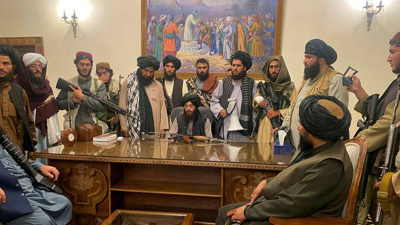
The post-American power vacuum in the region will aid China and shape India’s strategic choices and behavior

“The return of the Taliban to Kabul has effectively laid India’s ‘mission Central Asia’ to rest. If New Delhi could not find its way to Central Asia with encouraging partners such as Iran and the Hamid Karzai/Ashraf Ghani governments, the possibility of New Delhi doing so now is next to nil. India’s diplomatic and civilian presence as well as its civilian investments will now be at the mercy of the Taliban, and to some extent Pakistan. If there is a concerted effort by China, Pakistan and the Taliban to erase the Indian presence from Afghanistan, there is little India can do about it.”
The fall of Kabul in the wake of the American withdrawal from Afghanistan will prove to be a defining moment for the region and the future shape of its geopolitics; it would be as defining, if not more, as the Soviet intervention in 1979 and the American one in 2001. While a lot depends on the Taliban’s actual conduct both domestically as well as on the southern and western Asian geopolitical chessboard in the months ahead, the Taliban are likely to continue as a ‘useful villain’ in the unfolding great power competition. For New Delhi, the fall of Kabul is a moment of reckoning and it must rethink its regional strategies and options. Unfortunately, of the latter, it does not have many.
A vacuum
What is most disconcerting is the regional power vacuum in the Eurasian heartland created by the haphazard manner in which the United States withdrew from Afghanistan and its potential knock-on effects. An axis of regional powers such as China, Pakistan, Russia, and the Taliban, have already started filling this power vacuum, shaping, thereby, the contours of the region’s geopolitics based on their individual and common interests. Iran might also jump on this opportunistic bandwagon under the Chinese leadership.
What is abundantly clear is that each of these countries harbor deep anti-American feelings in varying degrees which will further shrink the American influence in the Eurasian heartland. While it is too early to determine whether what these countries have on their hands is an opportunity or a ticking bomb, the U.S., as a direct consequence of the formation of this axis, might decide to explore new ways of working with them to stabilize the region, if it desires to do so, and remain relevant there. If indeed that happens, could it result in a potential softening of the American rhetoric against China, Pakistan, Russia and perhaps even Iran? More so, what would that mean for India? While a healthy conversation among the great powers — the U.S., China and Russia — on global and regional challenges is a good sign, India is neither a great power nor present at the table. New Delhi must ensure that it does not become a casualty on the south-western Asian geopolitical chessboard.
Advantage China; extremism
The post-American power vacuum in the region will be primarily advantageous to China and its grand strategic plans for the region. Beijing will further strengthen its efforts to bring every country in the region, except India, on the Chinese Belt and Road Initiative bandwagon, thereby altering the geopolitical and geoeconomics foundations of the region. More so, the much-feared Chinese encirclement of India will become ever more pronounced. Having been further emboldened by the U.S.’s withdrawal and in stamping its writ on the region, Beijing is likely to become less accommodative towards India including on the Line of Actual Control. Even in trade, given the sorry state of the post-COVID-19 Indian economy, India needs trade with China more than the other way round. Unless New Delhi can find ways of ensuring a rapprochement with China, it must expect Beijing to challenge India on occasion, and be prepared for it.
The bigger challenge for India though would be a near-certain increase in terrorism and extremism in the region. The U.S. presence in Afghanistan, international pressure on the Taliban and Financial Action Task Force worries in Pakistan had a relatively moderating effect on the region’s terror ecosystem. With the Taliban now back in Kabul, things are bound to change. The visuals of the Taliban releasing terrorists from Afghan jails would send a powerful message to their fellow travelers, handlers, and sympathizers in the region.
While the neighboring countries are also worried about terrorism emanating from Afghanistan, the reality is that they are busy making their own private deals with the Taliban to not host terror organizations targeting them. There is little appetite for a regional approach to curbing terrorism from a Taliban-led Afghanistan. This enables the Taliban to engage in a selective treatment towards terror outfits present there or they have relations with. Moreover, given that the international community may have no choice but to recognize the Taliban regime — UN Security Council members such as China and Russia have already indicated their intent to do so — would also mean that the Taliban would hold more power in a bargain on the terror question. Sanctions are unlikely to deter an outfit that does not need to bother about the next election.
It is unlikely that the Taliban will proactively export terror to other countries unless of course for tactical purposes by, say for instance, Pakistan against India. The real worry, however, is the inspiration that disgruntled elements in the region will draw from the Taliban’s victory against the world’s sole superpower.
To that extent, the triumphalism in Pakistan over the Taliban’s victory in Afghanistan could eventually become counterproductive for Pakistan itself. Whether Pakistan Prime Minister Imran Khan refers to them as a force that has ‘unshackled the chains of slavery’ or the country’s deep state considers them as a strategic asset, the reality is that many anti-Pakistan terror organizations would be emboldened as well.
Impact on regional interests
The return of the Taliban to Kabul has effectively laid India’s ‘mission Central Asia’ to rest. If New Delhi could not find its way to Central Asia with encouraging partners such as Iran and the Hamid Karzai/Ashraf Ghani governments, the possibility of New Delhi doing so now is next to nil. India’s diplomatic and civilian presence as well as its civilian investments will now be at the mercy of the Taliban, and to some extent Pakistan. If there is a concerted effort by China, Pakistan and the Taliban to erase the Indian presence from Afghanistan, there is little India can do about it. Had New Delhi, as I had argued earlier, cultivated deeper relations (which by no means would have meant recognizing the outfit) with the Taliban, Indian interests would have been more secure in a post-American Afghanistan. New Delhi’s lack of strategic foresight will prove to be costly.
What is perhaps not yet understood is how the rise of the anti-America axis (China, Russia, Iran, Pakistan and a Taliban-led Afghanistan) and anti-American sentiments in the region would impact India’s regional interests given that it has become closer to the U.S. than ever before in its history. We have to wait and see what this mismatch between the region’s mood and India’s strategic choices would mean for the country. There is little doubt that because of these developments, India’s regional ambitions will take a major hit in the months and years ahead.
The fall of Kabul and the consequent knock-on effects in the region will have several potential implications for India’s foreign policy and its strategic choices and behavior. For one, given the little physical access India has to its north-western landmass, its focus is bound to shift more to the Indo-Pacific even though a maritime grand strategy may not necessarily be an answer to its continental challenges. Second, New Delhi might also seek to shed the arrogance it displayed towards its smaller neighbors during Modi 1.0 and cultivate friendly relations with them. Myanmar is a case in point. India has already indicated that it would not challenge the junta on the coup and its widespread human rights violations. This policy is likely to continue even if the Joe Biden administration seeks New Delhi’s help in turning up the heat on Myanmar’s generals. The last thing New Delhi needs now is an angry neighbor rushing to China.
India-Pakistan ties
Third, the developments in Afghanistan could nudge New Delhi to seek stability, if not peace, with Pakistan. While there is little desire in New Delhi today to reopen a broad-based dialogue process with Pakistan, even a ‘cold peace’ would be in India’s interest. For Pakistan too, such a ‘cold peace’ will help it to focus its energies on consolidating its interests and gains in Afghanistan. As a result, both sides might refrain from indulging in competitive risk-taking unless something dramatic happens which is always a possibility between the two rivals. That said, stability between India and Pakistan depends a great deal on how politics in Kashmir plays out, and whether New Delhi is able to pacify the aggrieved sections in the Valley.
The lesson for India in the wake of these developments is clear: It will have to fight its own battles. So, it must make enemies wisely, choose friends carefully, rekindle flickering friendships, and make peace while it can.
(The author is Associate Professor, Centre for International Politics, Organization and Disarmament, School of International Studies, Jawaharlal Nehru University, New Delhi)





Be the first to comment